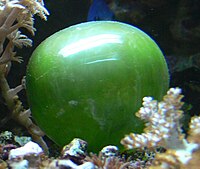
Photo from wikipedia
Abstract Stromatolites of the ~3.48 billion–year–old Dresser Formation (Pilbara Craton, Western Australia) provide some of the oldest convincing evidence of life on Earth. Here, we augment previous evidence with a… Click to show full abstract
Abstract Stromatolites of the ~3.48 billion–year–old Dresser Formation (Pilbara Craton, Western Australia) provide some of the oldest convincing evidence of life on Earth. Here, we augment previous evidence with a detailed investigation of the concentrations and distributions of various transition metals (Cr, Mn, Co, Ni, Cu, Zn, Mo, Se, Ag, Sn, Au, Hg, and Pb) and metalloids (As, Sb, and Te) in unweathered samples of strongly sulfidized stromatolites from drill cores. High–resolution elemental mapping and in situ compositional analysis of sulfides (pyrite and sphalerite) show that these sedimentary and hydrothermally sourced elements are strongly concentrated in texturally distinctive, nano-porous pyrite enriched in autochthonous organic matter, which forms the major, petrogenetically earliest component of wrinkly laminated and digitate growth fabrics within the stromatolites. Repeated cyclic alternations of various transition metals and metalloids (most importantly Ni and Zn), plus the presence of disconformities and overgrowth relationships between wrinkly stromatolite laminae, suggest that these element accumulations were primarily established by depositional processes during continuous stromatolite formation. Because transition metals and metalloids generally have strong affinities for organic matter, and can play active roles in biochemical processes, we interpret these element accumulations in the Dresser Formation stromatolites to be the result of binding to organic matter of living microbial communities and/or dead biomass, and perhaps also microbial utilization. Collectively, our results show that the precise characterization of transition metal–metalloid concentrations and distributions can unveil element enrichment patterns suggestive of biological activity, even in some of Earth’s oldest stromatolites.
Journal Title: Precambrian Research
Year Published: 2020
Link to full text (if available)
Share on Social Media: Sign Up to like & get
recommendations!